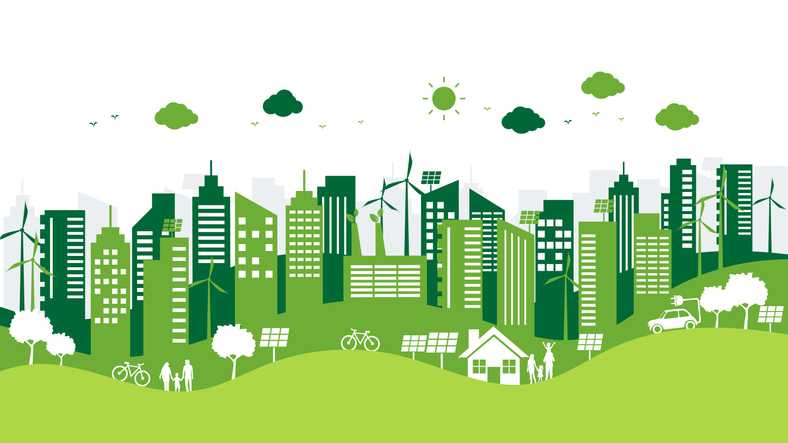
Update: As of June 6, 2024, the U.S. Department of Energy has finalized the federal definition for net zero buildings. Many of the changes are in line with our recommendations below.
Real estate actors, certifiers, advocates, and policy makers are increasingly using the term “net zero emissions building.” But, what precisely makes a building net zero emissions? Lacking a common definition, different players mean very different things, and it is difficult to hold players accountable for their assertions. Recently, the Biden-Harris Administration proposed a definition to greatly increase standardization, consistency, transparency, and accountability.
Following the initial announcement from the White House this past September, the U.S. Department of Energy (DOE) issued a Request for Information (RFI) for the public to provide input on that proposed definition by February 5, 2024. IMT’s official response is now available. You can also read, below, our initial assessment.
Why have this definition?
While on the surface a zero-emissions building sounds simple, anyone who designs or operates buildings knows that is not the case. A definition provides consistency in evaluating buildings and a goal towards which plans can be made. It takes time to change a building and its systems, particularly if we are talking about eliminating onsite fossil fuel, and providing a goal with clear parameters helps pave the way towards a zero-emission built environment. Two major benefits are consistency and long-term goal setting.
Consistency
When setting climate goals, local, state, and national governments typically include a target around building emissions; this is because buildings can comprise up to 75% of emissions in urban areas, and buildings account for a third of emissions in the US. Regulations, in the form of energy codes, and other policies like Building Performance Standards (BPS), vary significantly in their stringency from jurisdiction to jurisdiction. A unified federal net zero definition that defines an ultimate target and includes minimum efficiency requirements for both new and existing buildings will help to align jurisdictional policies, moving them towards the same targets over time. Moreover, as we discuss below, the proposed definition’s treatment of emissions from energy paid for by tenants is fundamentally better than the way that much of the corporate real estate sector tracks emissions. Better alignment across the board is needed and ultimately better for the industry.
Long-term goal setting
For properties that currently utilize fossil fuel systems, retrofits are often not as simple as switching out one piece of equipment for another. Whole system replacements may be required and infrastructure such as piping, ductwork, and power supply may need to be replaced or upgraded, which is a costly and invasive process. A defined goal that covers multiple aspects of building systems, including direct and indirect efficiency and fuel use, will provide a roadmap for long-term capital planning.
What is the proposed definition?
At its core, the definition is very simple and globally applicable—at least when reduced to a single sentence. According to the definition, a zero operating emissions building is a building that is “highly energy efficient, free of on-site emissions from energy use, and powered solely by clean energy sources.”
However, in practice, each of these elements is itself highly complicated. The full proposed definition, “National Definition of a Zero Emissions Building: Part 1 Operating Emissions,” goes on to define DOE’s approach to each in more detail, in a US-specific context. The approach also differs for new construction versus existing buildings. So, let’s unpack it:
Analysis of the proposed definition
| Criteria | Proposed Approach | Default Assessment | Exceptions / Alternates |
| Highly energy efficient | “The existing building’s energy performance places it among the top 25% most efficient buildings in the market with a similar use, based on measured whole-building energy use” | For existing buildings: an ENERGY STAR score of 75 or above | For building types not eligible for an ENERGY STAR Score, measured whole building EUI must be at least 35% lower than median EUI for that building type |
| “The new building’s estimated whole building energy use is at least 10% lower than required by the latest model code and the building is designed to achieve energy performance in the top 10% of similar buildings” | For new buildings: modeled energy use at least 10% lower than permitted by the latest IECC or ASHRAE 90.1 model energy code AND Buildings eligible for an ENERGY STAR score must achieve a “Designed to Earn the ENERGY STAR” score of 90 or above | Buildings not eligible for an ENERGY STAR score need only have a modeled EUI at least 10% lower than the latest model code | |
| Free of on-site emissions from energy use | “The building’s direct greenhouse gas emissions from energy use equal zero” | Zero reported (existing buildings) or modeled (new construction) energy use from sources with direct emissions (gas, oil, etc.) | Emissions from the testing and use of emergency backup generators are excluded |
| Powered solely from clean energy | “All the building’s energy is from carbon free-sources… [including] both onsite generation and offsite sources” | Energy generated and used on-site + procured off-site renewable energy use. Renewable generation is most commonly accounted for with Renewable Energy Certificates (RECs), which must be Green-e certified and retired after use, and the generation must be additional | Other off-site energy procurement– including ‘green’ district energy–that meets requirements of ASHRAE 228 or the EPA Green Power Partnership |
While ‘net zero’ is a common term, the proposed definition does not include ‘net’ and does not allow any use of carbon offsets. DOE proposes that the definition be verifiable through ENERGY STAR Portfolio Manager, which will greatly simplify the calculation process, especially for relative metrics like energy efficiency. The reliance on ENERGY STAR will limit the definition’s use to the United States and Canada, but we deem this a small price to pay for the transparency and simplicity that ENERGY STAR provides. DOE and EPA do not propose to go a step further to offer a zero emissions certification as such; however, ENERGY STAR will soon publish a NextGen certification for commercial buildings for low-carbon, not zero-carbon buildings. For any certifications based on the definition, it would make sense to differentiate buildings that meet the definition of a net-zero emissions building via modeling from buildings that meet the definition through the more rigorous path of measured performance.
Whole building energy use as a foundation
There is one critical element that underlies the whole definition, but is not clearly stated in the summary text as it could be: for a “building” to be a zero emissions building, the energy use and emissions must be assessed at the whole building level. When stated that way, it seems obvious, no? ENERGY STAR benchmarking is based on measurements of whole building energy use and their associated emissions, as are most green building certifications and building codes; energy modeling typically also looks at the whole building.
So why does the whole-building lens need to be called out more clearly in the summary definition? Because it is not in fact how much of the real estate industry is currently calculating net zero (at least at the portfolio scale). Under the GHG Protocol, GHG emissions reporting is sorted into Scopes 1, 2, and 3. For companies, there are several ways to draw the boundary and assign portions of emissions of a building scopes, based on operational control, financial control, or equity share. Under some of these approaches, the emissions from tenant spaces where tenants pay their own bills are considered Scope 3 emissions (community and national inventories take a different approach to the scopes, based on geography.) Many current corporate net-zero and science-based-targets (SBT) commitments only address Scopes 1 & 2—so for a substantial portion of their portfolios, companies may only be including central systems and common areas. At the portfolio and global levels, these GHG scope boundaries are useful, as they reduce double-counting between GHG inventories of different companies. But this accounting has limited relevance to the emissions of a single, whole building—precisely why efficiency and green building standards also don’t reference them. To avoid confusion, the definition should emphasize its whole building lens and avoid mentioning GHG emission “scopes” at all.
The industry focus on owner-paid energy use is also motivated in part by the fact that it can be difficult for owners to collect tenant energy data. The need for access to this data should drive building owners towards the critical need for metering strategies, adding language requiring utilities to share usage data, and encouraging jurisdictions to implement IMT’s Model Utility Data Access Law. The definition should also drive owners to expand the use of green leases, which among their many benefits, can ensure clear accounting of renewable energy credits associated with tenant-paid electricity use.
The role of efficiency in net zero
The proposed definition’s inclusion of energy efficiency also differs from portfolio-level treatments of net zero emissions that do not look at the efficiency of buildings, but it is in alignment in principle with green building standards for zero emissions buildings like LEED Zero Carbon and ILFI Zero Carbon. Zero emission buildings must also be energy efficient to reduce energy needed from the grid and for renewable energy supply.
However, when translating an abstract idea like “energy efficiency” into practice, we run into a contradiction: A definition should provide consistency and certainty; yet, the way that energy efficiency is assessed today is almost always relative to other buildings, and based on evolving standards and datasets.
For example, model energy codes, which apply primarily to new construction, are updated on three-year cycles, generally increasing efficiency requirements each cycle. This means the performance requirement for new buildings will effectively become more stringent over time. The proposed definition requires the building to be designed to perform 10% better than the latest model code, and in the top 10% of similar buildings. While comparing a new building to the existing building stock seems odd, this approach is in line with the European Union’s Green Bond requirements, which similarly expect new buildings to perform 10% better than national requirements for “near-zero energy buildings” and to be in the top 15% compared to existing buildings. It is not a given that new buildings will meet both metrics. IMT’s back-of-the-envelope analysis shows that while some typical buildings built to 10% better than the latest DOE-evaluated version of Standard 90.1 (ASHRAE 90.1-2019) would be expected to meet this standard, others would not. In addition to the moving target, relying on estimated performance can be problematic since actual measured energy performance rarely matches designs made for code compliance (and which are not always made in the first place)–which is one of the reasons that existing green building certifications for zero emissions rely on actual performance.
For existing buildings, the definition for energy efficiency is based on exceeding an ENERGY STAR Score of 75 or performing 35% better than national median energy use intensities (EUIs). ENERGY STAR updates these reference points every four to seven years as new national reference data becomes available. In effect, this means that over time, a building that used to meet the zero emissions definition might cease to do so even if its energy usage does not change.
That being said, it is important for these industry benchmarks to continue moving as the average performance of the building stock improves. Regular improvement is foundational to the design of the ENERGY STAR program and to many building performance standards. Buildings meeting the net zero emissions definition should not be excluded from the expectation of progress just because they have addressed emissions. Otherwise, we will end up with buildings that have better energy performance than those that are classified as net zero emissions leading to market confusion, greenwashing accusations, and a devaluation of these assets. For building owners to recoup their investments and increase market value, an asset defined as net zero emissions should be perceived in the market as the ultimate high-performance building.
What is missing from the proposed definition
The current proposed definition is silent on refrigerants, embodied carbon, and grid interactivity. DOE states that “documentation of those elements may be required in future versions.” We agree that the omission of refrigerants and embodied carbon makes sense at this time. While there are low Global Warming Potential (GWP) refrigerants, few truly zero-carbon options are in widespread use. Similarly, the movement to address embodied carbon (a.k.a. lifecycle carbon or upfront carbon) is appropriately focused on reducing high carbon sources as an urgent first step. While there are also limitations in the area of grid-interactivity, being able to adjust when energy is used is critical to limiting strain on the grid, and will become more so as we grow closer to our goal of eliminating onsite emissions in buildings. IMT views expanding the definition to address this important aspect of decarbonization as something that should be undertaken sooner rather than later.
Summary takeaways and recommendations
Based on an initial reading:
- There is a clear need for a consistent definition for zero emissions buildings so the industry has clear standards that will minimize greenwashing.
- The proposed definition provides a holistic framework for goals and effectively addresses tenant energy use.
- The proposed definition’s assumption of whole building energy use is critical, but should be stated more clearly, with references to emission scopes removed to avoid confusion.
- The proposed definition poses challenges in that the standards will be subject to change. This is necessary, but will also be difficult unless building managers proactively plan for continuous improvement.


